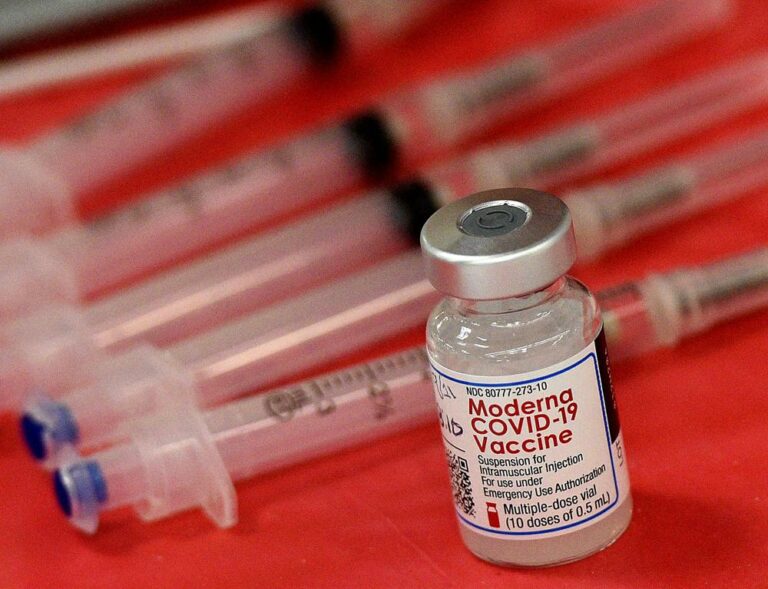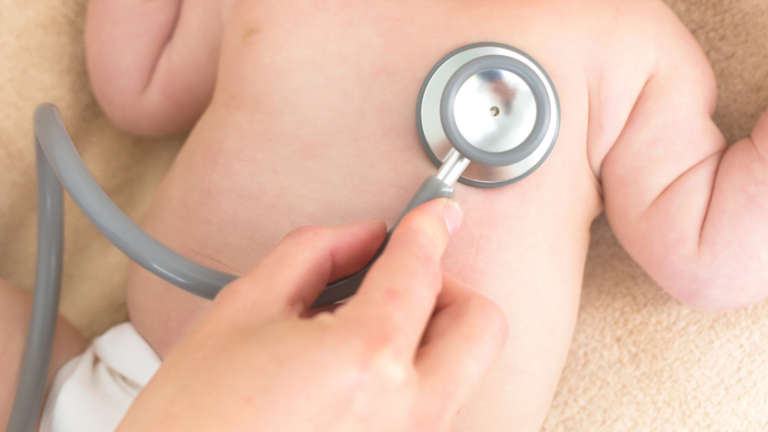Moderna is seeking to be the first to offer COVID-19 vaccine for the youngest American children, as it asked the Food and Drug Administration Thursday to clear low-dose shots for babies, toddlers and preschoolers.
Frustrated families are waiting impatiently for a chance to protect the nation’s littlest kids as all around them people shed masks and other public health precautions — even though highly contagious coronavirus mutants continue to spread. Already about three-quarters of children of all ages show signs they’ve been infected at some point during the pandemic.
Moderna submitted data to the Food and Drug Administration that it hopes will prove two low-dose shots can protect children younger than 6 — although the effectiveness wasn’t nearly as high in kids tested during the omicron surge as earlier in the pandemic.
“There is an important unmet medical need here with these youngest kids,” Dr. Paul Burton, Moderna’s chief medical officer, told The Associated Press. Two kid-size shots “will safely protect them. I think it is likely that over time they will need additional doses. But we’re working on that.”
Moderna said two kid doses were about 40% to 50% effective at preventing symptomatic COVID-19, not a home run but for many parents, any protection would be better than none.
That effectiveness is “less than optimal. We were hoping for better efficacy but this is a first step,” said Dr. Nimmi Rajagopal of Cook County Health in Chicago. She’s anxiously awaiting vaccinations for her youngest patients and her own 3-year-old son who’s ready to enter preschool.
“It gives me such peace of mind to know that hopefully by fall I’ll get him in school and he’ll be fully vaccinated,” she said.
Now, only children ages 5 or older can be vaccinated in the U.S., using rival Pfizer’s vaccine, leaving 18 million younger tots unprotected.
Moderna’s vaccine isn’t the only one in the race. Pfizer is soon expected to announce if three of its even smaller-dose shots work for the littlest kids, months after the disappointing discovery that two doses weren’t quite strong enough.
Whether it’s one company’s shots or both, FDA vaccine chief Dr. Peter Marks said the agency will “move quickly without sacrificing our standards” in deciding if tot-sized doses are safe and effective.
While questions are swirling about what’s taking so long, Marks pointedly told lawmakers earlier this week that the FDA can’t evaluate a product until a manufacturer completes its application. In a statement Thursday, the FDA said it will schedule a meeting to publicly debate Moderna’s evidence with its independent scientific advisers but that the company still must submit some additional data. Moderna expects to do so next week.
“It’s critically important that we have the proper evaluation so that parents will have trust in any vaccines that we authorize,” Marks told a Senate committee.
If FDA clears vaccinations for the littlest, next the Centers for Disease Control and Prevention would have to recommend who needs them — all tots or just those at higher risk from COVID-19.
“It’s very important to get the youngest children vaccinated” but “moving quickly doesn’t mean moving sloppily,” said Dr. Philip Landrigan, a pediatrician and public health expert at Boston College. FDA must “see if it’s safe. They need to see if it’s effective. And they need to do so swiftly. But they won’t cut corners.”
Many parents are desperate for whichever vaccine gets to the scientific finish line first.
“We’ve been kind of left behind as everybody else moves on,” said Meagan Dunphy-Daly, a Duke University marine biologist whose 6-year-old daughter is vaccinated — but whose 3-year-old and 18-month-old sons are part of Pfizer’s trial.
The family continues to mask and take other precautions until it’s clear if the boys got real vaccine or dummy shots. If it turns out they weren’t protected in the Pfizer study and Moderna’s shots are cleared first, Dunphy-Daly said she’d seek them for her sons.
“I will feel such a sense of relief when I know my boys are vaccinated and that the risk of them getting a serious infection is so low,” she said.
The FDA will face some complex questions.
In a study of 6,700 kids ages 6 months through 5 years, two Moderna shots — each a quarter of the regular dose — triggered high levels of virus-fighting antibodies, the same amount proven to protect young adults, Burton said. There were no serious side effects, and the shots triggered fewer high fevers than other routine vaccinations.
But depending on how researchers measured, the vaccine proved at best about 51% effective at preventing COVID-19 cases in babies and toddlers and about 37% effective in the 2- to 5-year-olds. Burton blamed the omicron variant’s ability to partially evade vaccine immunity, noting that unboosted adults showed similarly less effectiveness against milder omicron infections. While no children became severely ill during the study, he said high antibody levels are a proxy for protection against more serious illness — and the company will test a child booster dose.
“That’s not totally out of the realm of what we would have expected,” said Dr. Bill Muller of Northwestern University, who helped with Moderna’s child studies. “Down the road I would anticipate it’s going to be a three-shot series.”
Another issue: So far in the U.S., Moderna’s vaccine is restricted to adults. Other countries have expanded the shot to kids as young as 6. But while Moderna has filed FDA applications for older kids, too, the FDA hasn’t ruled on them. Months ago the agency cited concern about a rare side effect, heart inflammation, in teen boys, a concern that hasn’t been reported in much younger children.
It’s not clear if FDA will consider Moderna’s vaccine for children of all ages now or focus first on the littlest. But Muller already has had lots of parents ask why shots were being tested in tots before older kids were vaccinated — and says pediatricians and pharmacists must be ready with answers.
Burton said safety data from millions of older children given Moderna vaccinations abroad should help reassure parents.
While COVID-19 generally isn’t as dangerous in youngsters as adults, some do become severely ill or even die. About 475 children younger than 5 have died from COVID-19 since the pandemic’s start, according to the CDC, and child hospitalizations soared at omicron’s peak.
Yet it’s not clear how many parents intend to vaccinate the youngest kids. Less than a third of children ages 5 to 11 have had two vaccinations, and 58% of those ages 12 to 17.
(AP)












8 Responses
If your child is injured by these vaccines, just remember you will get zero help from the manufacturers, the government, and the doctors.
Oh definitely I am frustrated
I am ANXIOUSLY awaiting the day I can give my healthy children a poorly tested vaccine that has limited and short term effectiveness for a virus that they are most likely already immune to
leaving 18 million younger tots unprotected. which is an absolute despicable unacceptable disgrace & ineptitude on part of both fauci & sleepy joe, both simply not capable of warp speed as was President Donald Trump.
get it through your head
CHILDREN ARE NOT AT RISK!!!!
Even the AP (Always Propaganda) admits at the very end (after deceivingly making it seem like “parents” are pushing the government to do this (of course that’s not it):
“While COVID-19 generally isn’t as dangerous in youngsters as adults, some do become severely ill or even die. About 475 children younger than 5 have died from COVID-19 since the pandemic’s start, according to the CDC…”
That number 475 doesn’t consider how many died WITH Covid (probably most, if not all, of those 475) rather than FROM Covid. Of the rest, whose cause of death was Covid, it doesn’t indicate how many had a co-morbidity (presumably all).
But, of course, the AP doesn’t talk about any of that.
Even assuming it is “Gospel Truth” that 475 children in this country, aged 0-5, died from Covid, and disregarding that at least some of those (perhaps all?) 475 must have had some other health issues at the same time, the AP doesn’t provide any context, like out of how many children is that number 475 or what percentage of children is that number 475.
Looking at the stats online, let’s say that there are about 20,000,000 (twenty million) children in that age group in this country. Out of 20 Million, the AP indicates that there were 475 deaths. That’s 0.00002375 of the population. By comparison, the probability of being struck by lightning is indicated at 0.000002.
Every medical treatment, even ibuprofen, has at least some risk. These shots (injected into the bloodstream rather than orally ingested) also have at least some side effects. So, in addition to the above, the risk of side effects would need to be even less than the number above, 0.00002375, or whatever is the exact number, in order to “follow the science”.
If your child is injured by Covid-19, just remember you will get zero help from VelvelBenGenya.
What a clever comment by huju! You must have stayed up all night thinking of it. naar.